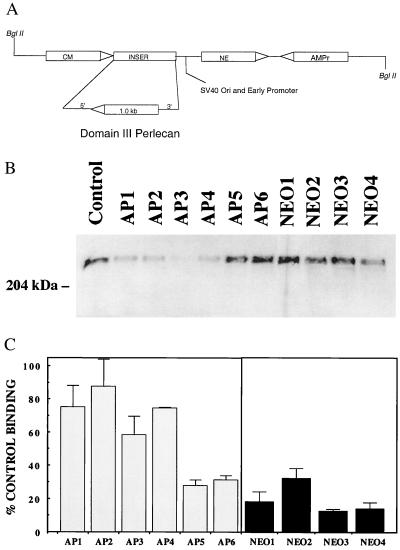Figure 1.
Expression of perlecan antisense leads to reduced perlecan secretion and loss of FGF-2 binding inhibition in endothelial cell-conditioned media. (A) Perlecan antisense construct. (B) Western blot of conditioned media from untransfected BAE cells, and clones transfected with the antiperlecan sequences (BAE-AP1–6) or the vector alone (BAE-NEO1–4). All samples were normalized for cell number (1 × 104 cells) and subjected to heparinase treatment before gel electrophoresis. (C) FGF-2 binding to smooth muscle cells is inhibited by conditioned media from BAE-NEO cells to a greater extent than by that from BAE-AP cells 125I-FGF-2 binding (2 ng/ml) to VSMCs was conducted as described (10). VSMCs were plated (5 × 104 cells/well) in 24-well culture plates (Costar) in DMEM, 10% calf serum. When the cells reached confluence (day 3), the medium was removed, and the monolayers were washed with cold (0°C) binding buffer (DMEM/25 mM Hepes/0.05% gelatin), and binding of 125I-FGF-2 was conducted in the presence of conditioned media (equivalent to the media conditioned by 3.5 × 104 cells) for 2.5 h at 4°C. The data shown are the averages ± SEM of triplicate determinations. Control binding represented the amount of 125I-FGF-2 bound to cells in the absence of any conditioned media (100%).

